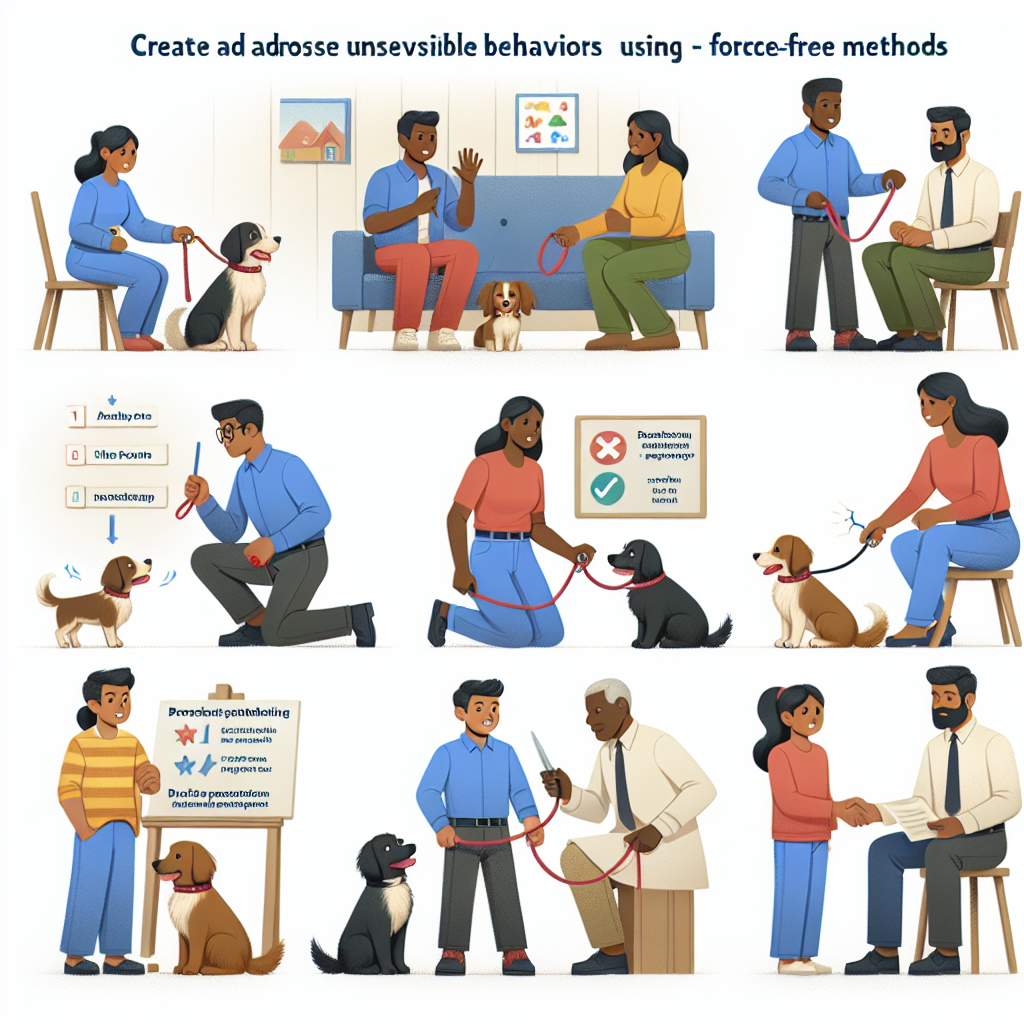How to Address Undesirable Behaviors Using Force-Free Methods
Table of Contents
Addressing undesirable behaviors in animals using force-free methods involves understanding and applying positive reinforcement techniques to encourage desired behaviors without resorting to punishment or coercion. This approach is rooted in the principles of behavioral science, emphasizing the importance of building trust and fostering a positive relationship between the animal and the handler. By focusing on rewarding good behavior rather than punishing bad behavior, force-free methods aim to create a stress-free environment that promotes learning and cooperation. This introduction will explore the key concepts and strategies involved in implementing force-free techniques to effectively manage and modify undesirable behaviors in animals.
Understanding the Principles of Force-Free Behavior Modification
Force-free behavior modification is an approach that emphasizes the importance of understanding and addressing undesirable behaviors in a compassionate and effective manner. This method is grounded in the principles of positive reinforcement, which focuses on encouraging desired behaviors through rewards rather than using punishment or coercion. By employing force-free techniques, individuals can foster a more harmonious relationship with their pets, leading to improved behavior and a stronger bond.
To begin with, it is essential to recognize that undesirable behaviors often stem from unmet needs or misunderstandings. Animals, much like humans, communicate through their actions, and what may appear as misbehavior could be an expression of stress, fear, or confusion. Therefore, the first step in addressing these behaviors is to identify the underlying cause. This requires careful observation and a willingness to consider the animal’s perspective. By understanding the root of the problem, one can tailor a more effective and compassionate response.
Once the cause of the behavior is identified, the next step is to employ positive reinforcement techniques. This involves rewarding the animal for exhibiting the desired behavior, thereby increasing the likelihood of its recurrence. Rewards can take various forms, such as treats, praise, or playtime, and should be given immediately after the desired behavior to reinforce the connection. It is crucial to be consistent in this approach, as inconsistency can lead to confusion and hinder progress.
In addition to positive reinforcement, it is important to manage the environment to prevent the occurrence of undesirable behaviors. This can involve removing triggers that may lead to unwanted actions or providing alternative outlets for natural behaviors. For instance, if a dog tends to chew on furniture, providing appropriate chew toys can redirect this behavior in a positive way. By setting the animal up for success, one can reduce the likelihood of undesirable behaviors manifesting.
Moreover, patience and persistence are key components of force-free behavior modification. Change does not happen overnight, and it is important to remain committed to the process. Setbacks may occur, but they should be viewed as opportunities for learning and growth rather than failures. By maintaining a positive and patient attitude, individuals can create a supportive environment that encourages progress.
Furthermore, it is beneficial to educate oneself about animal behavior and training techniques. Understanding the science behind behavior modification can provide valuable insights and enhance one’s ability to implement effective strategies. There are numerous resources available, including books, online courses, and professional trainers who specialize in force-free methods. Seeking guidance from experts can be particularly helpful in addressing complex or persistent behavioral issues.
In conclusion, addressing undesirable behaviors using force-free methods is a compassionate and effective approach that prioritizes the well-being of the animal. By understanding the underlying causes of behavior, employing positive reinforcement, managing the environment, and remaining patient and informed, individuals can successfully modify behavior without resorting to force or punishment. This not only leads to improved behavior but also strengthens the bond between humans and their animal companions, fostering a relationship built on trust and mutual respect. As more people embrace these principles, the benefits of force-free behavior modification will continue to be realized, promoting a more humane and understanding approach to animal care.
Implementing Positive Reinforcement Techniques for Behavior Change

Implementing positive reinforcement techniques for behavior change is a compassionate and effective approach to addressing undesirable behaviors in both animals and humans. This method, rooted in the principles of operant conditioning, emphasizes the importance of reinforcing desired behaviors rather than punishing unwanted ones. By focusing on positive reinforcement, individuals can foster an environment that encourages learning and growth, ultimately leading to more sustainable behavior change.
To begin with, it is essential to understand the core concept of positive reinforcement. This technique involves the addition of a rewarding stimulus following a desired behavior, thereby increasing the likelihood of that behavior being repeated in the future. For instance, when training a dog, offering a treat or verbal praise immediately after the animal performs a desired action, such as sitting on command, serves as a positive reinforcement. This approach not only strengthens the behavior but also builds a trusting relationship between the trainer and the animal.
Transitioning from traditional methods that may involve punishment or negative reinforcement to a force-free approach requires a shift in mindset. It is crucial to recognize that punishment can lead to fear, anxiety, and a breakdown in communication, which are counterproductive to behavior modification. Instead, by focusing on what the individual or animal does correctly and rewarding those actions, one can create a more positive and conducive learning environment. This shift not only enhances the effectiveness of the training but also promotes emotional well-being.
Moreover, implementing positive reinforcement techniques necessitates consistency and patience. It is important to consistently reward the desired behavior each time it occurs, especially in the initial stages of training. This consistency helps to establish a clear connection between the behavior and the reward, making it easier for the individual or animal to understand what is expected. Over time, as the behavior becomes more ingrained, the frequency of rewards can be gradually reduced, transitioning to intermittent reinforcement, which helps maintain the behavior in the long term.
In addition to consistency, timing plays a critical role in the success of positive reinforcement. The reward must be given immediately after the desired behavior to ensure that the connection between the action and the reward is clear. Delayed reinforcement can lead to confusion and may inadvertently reinforce an unintended behavior. Therefore, being attentive and prompt in delivering rewards is essential for effective behavior change.
Furthermore, it is important to tailor the rewards to the individual or animal being trained. What serves as a motivating reward can vary greatly among different individuals. For some, verbal praise or a simple pat on the back may suffice, while others may require tangible rewards such as treats or toys. Understanding these preferences and incorporating them into the training process can significantly enhance the effectiveness of positive reinforcement.
In conclusion, addressing undesirable behaviors using force-free methods through positive reinforcement is a humane and effective strategy. By focusing on rewarding desired behaviors, maintaining consistency, ensuring timely reinforcement, and personalizing rewards, individuals can foster an environment conducive to learning and growth. This approach not only leads to sustainable behavior change but also strengthens the bond between the trainer and the trainee, whether human or animal, creating a foundation of trust and mutual respect.
Creating a Supportive Environment to Prevent Undesirable Behaviors
Addressing undesirable behaviors in pets, particularly in dogs, requires a thoughtful approach that prioritizes the well-being of the animal while fostering a harmonious living environment. Force-free methods, which emphasize positive reinforcement and the avoidance of punishment, have gained traction as effective and humane strategies for behavior modification. Creating a supportive environment is a crucial first step in preventing undesirable behaviors, as it sets the stage for successful training and a positive relationship between the pet and owner.
To begin with, understanding the root causes of undesirable behaviors is essential. Often, these behaviors stem from unmet needs, such as lack of exercise, insufficient mental stimulation, or anxiety. By identifying and addressing these underlying issues, pet owners can create an environment that naturally discourages negative behaviors. For instance, ensuring that a dog receives adequate physical activity can significantly reduce instances of excessive barking or destructive chewing. Similarly, providing mental enrichment through puzzle toys or interactive games can alleviate boredom and prevent behaviors that arise from restlessness.
In addition to meeting the basic needs of the pet, establishing a consistent routine is another vital component of a supportive environment. Animals thrive on predictability, and a structured daily schedule can help reduce anxiety and promote good behavior. Regular feeding times, designated play sessions, and consistent training periods create a sense of security for the pet, making it easier for them to understand expectations and respond positively to guidance. Moreover, consistency in the owner’s behavior and responses is equally important. Mixed signals or inconsistent reactions to a pet’s actions can lead to confusion and hinder the learning process.
Furthermore, the physical environment plays a significant role in shaping a pet’s behavior. Pet-proofing the home by removing potential hazards and providing safe spaces can prevent accidents and reduce stress. For example, creating a designated area with comfortable bedding and toys can offer a retreat for the pet when they feel overwhelmed. Additionally, using barriers or gates to limit access to certain areas can prevent undesirable behaviors such as counter-surfing or inappropriate elimination. By proactively managing the environment, pet owners can minimize opportunities for negative behaviors to occur.
Transitioning to the training aspect, positive reinforcement is a cornerstone of force-free methods. This approach involves rewarding desired behaviors with treats, praise, or play, thereby encouraging the pet to repeat those actions. It is crucial to deliver rewards immediately after the desired behavior to reinforce the connection between the action and the reward. Over time, this method fosters a positive association with good behavior, making it more likely to be repeated. Importantly, force-free training avoids the use of punishment, which can lead to fear, anxiety, and even aggression in pets. Instead, redirecting undesirable behaviors and rewarding alternative actions is a more effective and humane strategy.
In conclusion, creating a supportive environment is fundamental to preventing undesirable behaviors in pets using force-free methods. By addressing the root causes of negative behaviors, establishing consistent routines, and managing the physical environment, pet owners can set the stage for successful behavior modification. Coupled with positive reinforcement training, these strategies promote a harmonious relationship between pets and their owners, ensuring a happy and well-adjusted companion. Through patience, understanding, and commitment, undesirable behaviors can be effectively managed, leading to a more fulfilling and stress-free coexistence.









